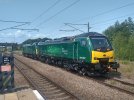Peter Sarf
Established Member
Goodness.....it sounds pretty simple doesn't it, but the reality is that it isnt. I think essentially F1 has had some of the same issues with drivers complaining of clipping (where engine power is diverted to charge the battery) at inopportune moments. And that's on a track with a known layout where they can pretty much map into the software what's needed.
With a locomotive you have a bit of a dilemma, how you deploy the battery, do you burn it up all at once pulling away using 100% battery before bringing the diesel in, but that of course limited total power.
What about charging? Do you charge to 100% using diesel at the first opportunity? doesnt sound very green, or do you wait until you can charge regeneratively? Nice and green, but not very useful if you have just used the battery energy, have a period coasting then could do with max power to get up a hill/ to mainline speed.
Using Wiki figures the dirty diesel engine outputs 1200hp and the battery a max of 540hp
Say for example it pulls away and 1600hp is demanded from the Various power sources. Does the battery give out say it's full output and the engine tops up? Is the demand shared more equally (less green)?
Then when train is underway at at a modest line speed the battery is say 50% depleted.
What then happens when the power demand reduces say to 1000hp?
Does the engine still run at 1200hp and pump 200hp back into the battery? That's great for the next time you need the umph, say when theine speed increased 40mph -75mph, but not so good for being green and recovering waste energy when you need to brake.
Does the computer manage all this or can the driver have a say? say for example having pulled away and now running at line speed reduces traction demand to 800hp he knows it's unlikely he'll need to brake and need the battery capacity for energy recovery, but does know there is a big hill a few miles down the road for which a fully charged battery would be useful for. Can he then override the system, run the engine up to 1200hp and charge the battery?
*yes of course there will be losses but you get my gist.
The possibilities and scenarios are endless. The problem with putting the human in the chair incharge is that they may not understand how to get the best out of the system, may not judge it well. Or may have different ideas and objectives, for example they may enjoy the power and performance of a fully charged battery and care little for the green credentials and fuel costs.
There is no perfect answer I don't think
It is enough to make continuous OHLE look very tempting ?.
I think this sums it up. A fairly decent automatic process that can, and will be, overridden by the driver. The overrides will be based on growing experience of the route(s) worked. The experience might be built up by individual drivers for themselves only OR perhaps some monitoring leading to recommendations laid down by on high to drivers. Probably aiming to reduce engine use as much as reasonably possible with the engine thrown in when a delay is to be overcome or an unexpected power outage.It is always important to utilise resources in a goal-oriented manner. And one of the most important, flexible and experienced resources is the driver. Many of our projects in connection with optimising rail operations in recent years have included a proportion of calculations performed by more or less intelligent algorithms. Hardly any of them involve automation at the users end. The aim is to provide the driver/signaller with the important information at the right time and in the appropriate way. I well remember that some employees with little experience of day-to-day operations were amazed at how precisely and efficiently a driver can drive a train on the target line of a timetable if you just let him. You don't always have to give him an exact target speed. A time when it should reach point X is sufficient. He can then utilise his knowledge of the terrain to reach this destination as efficiently as possible. The same will presumably also apply to the operation of such a locomotive. The train driver knows the lione and his planned driving strategy, so he can also utilise the system accordingly.
Of course, knowing how the lean and efficient world operates these day, the 93s will be working close to their limit with not much spare for recovery. It is what "should" happen rather than reality that decides things.


